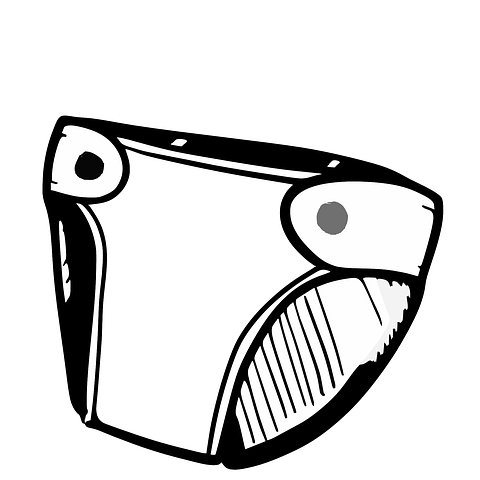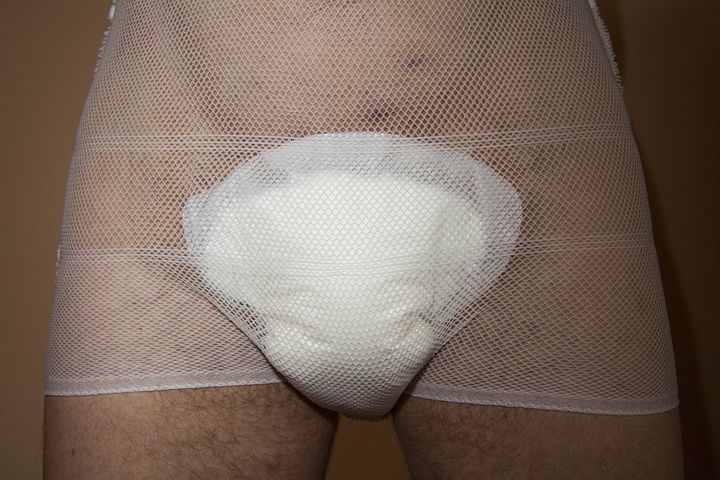Adult Diaper Changing - Caregiver Guide
An adult diaper, or brief as I like to call it, is an undergarment worn by patients with incontinence. Like diapers for infants, briefs come in many different sizes to fit patients of different sizes.
Why Brief? Changing Checking Alternatives Moisture

Why Brief?
Why do I call it a brief you ask? It's a habit I developed out of dignity for the patients. A lot of them already don't like the idea of wearing one, and if they hear it being called an adult diaper, they'll resent wearing one even more. It makes them feel comparable to a baby or a child who can't care for themselves.
They may not seem to mind on the outside, but just put yourself in their place. Nobody wants to wear one but if they have to, the term brief is just easier to swallow. Enough about what to call it, how do you put one on?
How To Put One On or Change One
If another caregiver is available to help, they would make this process much easier especially if the patient isn't able to assist you or they have dementia. Some patients are virtually impossible to change without help.
If they aren't able to turn due to an injury, or simply having generalized weakness, don't injure yourself by trying to do it all on your own. In the end, that causes not only you, but your patients to suffer. You are no good to them if you can't help them due to an injury.
If the patient is soiled, you also want to have either wipes or washcloths to perform perineal care. Make sure at least one of the washcloths is dampened with warm water and another is completely dry. You will more than likely need multiple washcloths if they had a bowel movement.
Wipe the patient's genitals thoroughly with the dampened washcloth and then pat them dry with the dry one. You don't want to leave moisture on the patient's skin or else it defeats the purpose. If they have a foley catheter, make sure you wipe around it as well at least four inches up the tubing coming out of the urethra.
With patients on bedrest, the best way to put an adult diaper on is to have them roll onto their side. An incontinence pad helps immensely if the patient can't roll on their own.
If they are able, ask the patient to grab the rail on the side of the bed that you are turning them, which will be the side you are on if they need lots of assistance. If they can turn well on their own or just need minimal assistance, it is best if you are on the opposite side from where they are turning. That way you don't have to reach over them to clean them. If the bed doesn't have a rail, be very careful. You don't want the patient rolling off the bed.
If they do need lots of help, grab the pad on the opposite side of where you are standing and slowly pull it upwards and towards you. This action helps assist the patient onto their side. Once they are in place, support the patient's back and bottom and put the pad back on the bed.
Again, if they are soiled wipe their bottom and in the creases around their bottom and legs thoroughly with the wipes or dampened washcloth and pat dry with the dry one. Then place barrier cream or a mepilex on their bottom if they have a bed sore or are starting to develop one.
Make sure the plastic side of the adult diaper goes on the outside of the patient while the soft cotton inside goes against their skin. Most briefs have four sticky flaps, two on each end. Place that half underneath the patient's bottom in such a way that it will be directly in the center of their buttocks once they roll back. Tuck the side with the sticky flaps underneath their hip as much as you can. The rest of the brief should be down by their legs.
Once it is in place, ask or assist them back flat onto their back. Then roll them the other way exactly how you did it the first time and pull out the rest of the brief. If they were turned onto their side fairly well, this roll should be a little faster and easier. They may not even have to roll all the way over. It just has to be enough for you to reach the brief underneath them.
The other end of the brief down at their legs should then be pulled up between their legs towards the stomach. Lay it flat and wrap the sticky flaps over the end on the stomach securing the brief. Make sure it is wrapped fairly snug so it doesn't slip off. At the same time though, make sure it isn't cutting off their circulation or damaging their skin.
Checking
Some patients wear briefs just as a precaution and are able to tell when they go while others are completely incontinent and don't know then they go.
With incontinent patients, it is best to check often to make sure it is dry. Every four hours minimum, however two hours would be better. Don't just go by smell, go by sight and feeling, with medical gloves if available. If they haven't urinated in more than eight hours, it may be a good idea to scan their bladder if there is a bladder scanner available.
Some adult diapers have a line going down the middle that changes color when they urinate. From my experience, I have learned not to trust these because they are very unreliable. Most of the urine may end up around the patient's bottom making it impossible to see. It is best to physically open the brief and possibly turn them to check if it is soiled.
 Mesh panties with feminine pad
Mesh panties with feminine padOther Alternatives
Some patients may prefer to use other methods to contain their incontinence such as adult pull ups. They are similar to adult diapers except you slip them on starting at the feet just like underwear. The downfall for them is that it can be rather difficult to slip them over their buttocks if they are on bedrest.
To take them off when they are soiled, I find it easier to just tear them where they connect at the seams. That way you don't have to drag it all the way down which could potentially getting urine or feces on their legs, feet, or bed linens. The seams are usually on either side around the hips. You will clearly be able to see the line where they connect. Just grip either side and tear. You'll be surprised how easily they separate.
Another method I have seen is a combination of mesh panties and an adult diaper or feminine pads in the crotch area. This method works similar to the pull ups. Refer to the picture for an example. Patients may prefer this because it feels more natural and they can also easily remove and replace the pads without completely taking off the mesh panties.
The Moisture Argument
I've heard an argument towards not using adult diapers when a patient is in bed even if they are incontinent. This is because they harbor moisture which can cause infection and pressure sores. The idea is to put the brief on while they are out and about, but to just place an incontinence pad underneath them while they are laying down. That way the pad catches all of the moisture and it doesn't stay against the skin.
This actually makes a lot of sense but it's something I haven't really thought much about. I'm not sure how new the idea is or how much it is practiced, but maybe it should be practiced more. The hospital where I am employed is now actually attempting to remove the usage of briefs in the facility. My argument would be that the pad would also harbor moisture, but it would be coming into contact with less skin. It's an interesting angle on the subject.
What do you all think? If any of you have heard or practice not using briefs while the patient is in bed, let me know in the comments below. If so, what has been your experience? Have there been less infections and bed sores? I'm curious to see if this practice has been studied enough to have a fair argument to be utilized more often.
List of Caregiver Supplies and Equipment
From Adult Diaper Changing - Caregiver Guide to Home
Recent Articles
-
Common Truck Crash Injuries and Legal Remedies - Caregiverology
Jul 19, 25 10:49 AM
Known for its sun-drenched beaches, vibrant arts scene, and bustling maritime industry, Fort Lauderdale is a city that sees heavy traffic both on its roads and at its busy port. Unfortunately, with th… -
Why Expert Legal Help Matters After Serious Injury - Caregiverology
Jul 19, 25 10:35 AM
In Houston, over 67,600 car crashes occurred in 2023, resulting in 290 fatalities and 1,612 serious injuries. That’s roughly 185 accidents every day. -
How Life Care Planners Support Injury Recovery - Caregiverology
Jul 19, 25 10:18 AM
In Los Angeles, life care planners play a vital role in supporting injury recovery, especially for individuals facing catastrophic injuries such as traumatic brain injuries or spinal cord damage.





New! Comments
Have something to say about what you just read? Leave a comment in the box below.